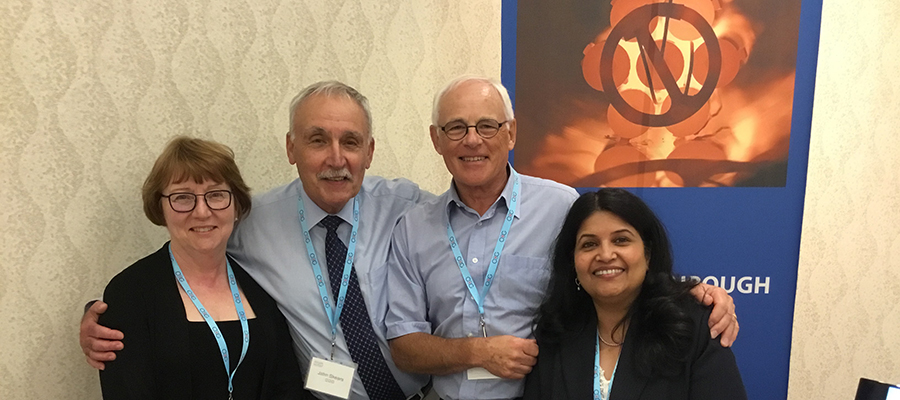
Research and Development
enables COG members to share the
risks, costs and the rewards of R&D
projects in six program areas: Nuclear Safety
and Licensing; Chemistry, Materials
and Components; Fuel Channels;
Health, Safety and the Environment;
and, the Industry Standard Toolset of
safety analysis codes. A Strategic R&D
program is also underway to ensure
long-term sustainability.
In the 2018-19 business year, COG invested almost $70 million in joint projects and R&D (about half in each line of business). According to the European Commission Joint Research Centre's annual global ranking, this is more than the R&D investment of a Top 15 Canadian private company. Each year, COG's R&D programs collectively manage hundreds of work packages in six program areas. New R&D programs are considered annually and member company employees are invited to nominate projects.
Each of the programs is managed by a COG Program Manager with technical direction coming from a Technical/Steering committee drawn from the participant Member organizations. Other resources, such as suppliers and representatives from universities or working groups for specific areas, may augment the technical committee.
COG R&D projects are managed through five base program areas:
- Fuel Channels: The Fuel Channel (FC) program managed by COG is mainly focussed on addressing the current operational need to improve confidence in the fitness-for-service of CANDU pressure tubes and developing industry standards for pressure tube integrity. Under normal operating conditions, the zirconium-niobium pressure tubes are exposed to high temperature, high internal pressure, high heavy water flow rates and high neutron flux. The resultant property changes, along with corrosion and deuterium ingress, which occur as the pressure tube ages, increase the susceptibility to cracking which is assessed in terms of fitness-for-service guidelines.
- Safety and Licensing: The S&L Program addresses issues relating to the safety design basis and safe operating envelope of existing nuclear plants, and has a strong focus on supporting the resolution of outstanding generic safety and licensing issues. There is an increasing focus on addressing plant aging and operational issues. In part, this work assists in maintaining the core capabilities, scientific expertise, and the infrastructure necessary for an ongoing nuclear safety R&D program. The main drivers for the program are safe operation and regulatory compliance, and reducing uncertainties in the licensees’regulatory positions.
- Health, Safety and Environment: The HS&E Program addresses issues related to worker health and safety – primarily the risks of radiation exposure, radiation monitoring and dosimetry; and related to environmental risk – identifying and monitoring emissions of concern (both radioactive and conventional), predicting risk to both human and non-human biota and implementing appropriate environmental monitoring.
- Chemistry, Materials & Components: The Chemistry, Materials & Components Program covers a diverse range of issues that can impact on the safe, reliable and efficient operation of the major CANDU systems and their auxiliaries, such as the Primary Heat Transport, Moderator, Steam Generators, Emergency Core Cooling and Containment. This includes optimizing the chemistry control regimes and understanding material aging effects in order to predict, manage and mitigate degradation of key components, such as Feeders and Steam Generators; and hence extend the asset life. There is also a strong focus on smaller components such as valves, cables, sealants, lubricants and other organically-based materials.
- Industry Standard Toolset: The Industry Standard Toolset (IST) Program is a consolidation of the qualification, development and maintenance activities on different computer codes used for the design, safety analysis and operational support of CANDU reactors.
The sixth area is COG's Strategic R&D program which was developed to set a long-term vision and create research that will help the CANDU industry remain sustainable and strong for future operations over the next several decades. Strategic R&D focuses on developing the technologies and other solutions for the current and refurbished fleet of CANDU reactors to keep units operating safely, reliably and competitively for an extended plant life of 60 to 90 years.
COG's eight Strategic R&D focus areas include:
• Outage reduction
• Enhance computer codes for improved safety margins
• Improved materials for extended reactor life
• Technology & infrastructure for decommissioning and waste
• Climate change impact assessment on CANDU
• Technology to reduce environmental impacts
• Advance knowledge and public acceptance on low-level radiation
• Human performance and organization aspects of nuclear generation
BY THE NUMBERS
$36 million | 300+ | 60-90 years |
COG
members invested about $36 million in research and development through COG
in the 2018-19 business year | COG
typically has more than 300 research projects on the go at any given time,
allowing members to meet priorities for safety, regulatory commitments,
improved reliability, added revenue and improved human capability. | The number of years of extended plant life the current and refurbished fleet of CANDU reactors could keep operating safely, reliably and competitively as COG's Strategic R&D program focuses on developing technologies and other solutions. |

